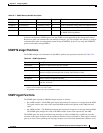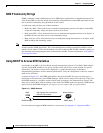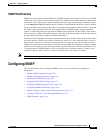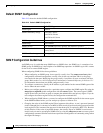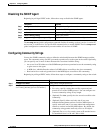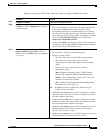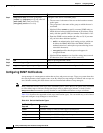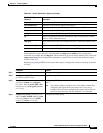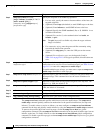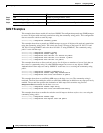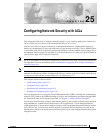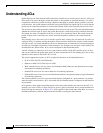
24-11
Catalyst 2950 Desktop Switch Software Configuration Guide
78-14982-01
Chapter 24 Configuring SNMP
Configuring SNMP
Some notification types cannot be controlled with the snmp-server enable global configuration
command, for example, tty and udp-port. These notification types are always enabled. You can use the
snmp-server host global configuration command to a specific host to receive the notification types
listed in Table 24-4.
Beginning in privileged EXEC mode, follow these steps to configure the switch to send traps or informs
to a host:
hsrp Generates a trap for Hot Standby Router Protocol (HSRP) changes.
mac-notification Generates a trap for MAC address notifications.
rtr Generates a trap for the SNMP Response Time Reporter (RTR).
snmp Generates a trap for SNMP-type notifications.
syslog Generates a trap for SNMP syslog notifications.
tty Sends Cisco enterprise-specific notifications when a Transmission Control
Protocol (TCP) connection closes.
udp-port Sends notification of the User Datagram Protocol (UDP) port number of the
host.
vlan-membership Generates a trap for SNMP VLAN membership changes.
vtp Generates a trap for VLAN Trunking Protocol (VTP) changes.
Table 24-4 Switch Notification Types (continued)
Notification Type
Keyword Description
Command Purpose
Step 1
configure terminal Enter global configuration mode.
Step 2
snmp-server engineID remote
ip-address engineid-string
Specify the engine ID for the remote host.
Step 3
snmp-server user username
groupname remote host [udp-port
port] {v1 | v2c | v3 [auth {md5 | sha}
auth-password]} [encrypted] [access
access-list]
Configure an SNMP user to be associated with the remote host created in
Step 2.
Note You cannot configure a remote user for an address without first
configuring the engine ID for the remote host. If you try to
configure the user before configuring the remote engine ID, you
receive an error message, and the command is not executed.
Step 4
snmp-server group [groupname {v1 |
v2c | v3 [auth | noauth | priv]}] [read
readview] [write writeview] [notify
notifyview] [access access-list]
Configure an SNMP group.



